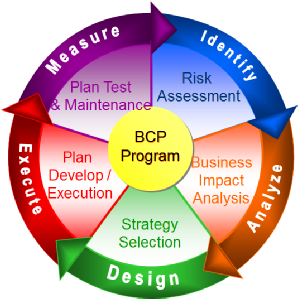

Business Continuity
Our approach includes:
- Integrated Continuity –
- build it in…
- keep it current
- Process Continuity –
- understand the flow…
- risk based
- Relationship Continuity –
- keep dependencies active
- Keep communications active
A Going Concern is all about keeping your business going – before, during and after an event. So naturally, we have a complete Business Continuity offering. We have chosen to use Business Continuity as the umbrella term covering emergency response and continuity planning. The reason – most companies do not have a dedicated emergency response role because they are not first responders and they are not governmental or quasi-governmental agencies. Most companies tend not to have fire departments or fully authorized police agencies, but for those of our clients that do, we build the emergency response plans separately from the continuity plans.
There is a second operational reason for merging the Emergency Response and Business Continuity activities. Having a consistent and working response center that takes you through the event - from response to recovery- is an essential element of success. The transitions of the phases can often be a struggle and lead to periods of indecision or lack of direction. Our approach simplifies the processes; it streamlines them and makes them function as a single unit. We believe that to be the best approach for most companies. (As we mentioned before – when it is not the best approach, we’ll break them apart and work with you to find the right approach for you.)
You can see from the box to the left, we have a few guiding principles that we use in planning. As a business building a plan that incorporates how we operate is a key factor. If we make our processes recoverable and build our recovery to utilize the same processes we use every day, we are much more likely to be able to function during the stress, confusion and chaos that is present during a disaster event. Naturally as the processes change, we need to be certain our plans are updated and modified to reflect those changes.
We focus on the business and the processes we use to accomplish our mission every day. All our business processes have a flow, all our processes have inputs and outputs; and all our processes have a timing that we need to understand. If you understand what you are doing, the flows and priorities of the processes, and can sequence them when things aren’t working perfectly, time can become your friend. This makes continuity is achievable.
While not our final principle in continuity planning, we believe that understanding the relationships and dependencies we have on others – internal and external to the company – is a key stone in the plan development process. Often a failure in a dependency outside of our direct control can result in a disaster if we are not prepared for the impact of that dependent task, service, supply part, etc.
A final thought to consider in building continuity plans. If the process is stressful, painful, and unpleasant, how likely are the participants to keep the plans current? “Borrowing a template” from someone else or a government Internet site does not make sense because it does not take you through the thought process which is a critical component when developing the program and understanding of the process for recovery. Using a guide just makes sense. This is what a good consultant should provide – a guide to bring you through the process and build your understanding and confidence in the plans you jointly develop. After all, we want you to be successful and be able to continue to be a going concern.

| Fred Bio |
| Keith Bio |
| Business Continuity |
| Technology Risk |
| Integrated Security |
| Operational Effectiveness |
| Memories Preservation |
| Ebola Hype |
| Risk Assessments for Health Care |
| Cyber Threat |
| Data Center Independence |